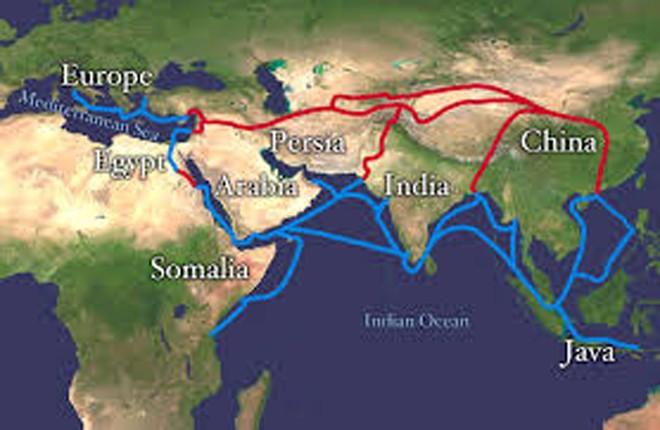
Stakeholders’ cooperation on the New Silk Road project might lead to Asian integration on the pattern of EU countries, while vicious competition amongst them could embroil Asia in a geopolitical unrest

Following the end of the cold war, the global community has been seized with efforts to reviving the Silk Road so as to give a boost to their economic activities.
Attracted by important location advantages, rich natural resources and broad prospects for development of regions along the Silk Road, some major countries, in recent years, have been propounding their strategic conceptions for the regions. Among these, the notable ones are: the EU "New Silk Road Project;" the US "New Silk Road Strategy;" the Japanese "Silk Road Diplomacy Strategy;" and the "North-South Corridor Plan" by India, Russia, etc.
In 1995, the European Commission proposed the European-Asian Transport Corridor project aimed at building the Europe-Caucasus-Caspian Sea-Black Sea-Central Asian transport passage. Since then, the Asian Development Bank (ADB), the UN Economic and Social Council (ECOSOC) and the United Nations Development Programme (UNDP) have been planning and funding Pan-Asian traffic network construction.
The International Road Federation (IRF) proposed in 1998 to revive the Silk Road Traffic Connections Programme. The IRF hosted three International Silk Road Conferences -- in 1998, 1999 and 2004. After the Gregorian year 2000, the United Nations Education and Scientific Conference (UNESCO) and the World Tourism Organization (WTO) have also been promoting the revival of the Silk Road from the perspective of culture.
Through construction of 3,300 kilometre Nabucco natural gas pipeline, the EU is strengthening contacts in energy, trade, personnel, information and other aspects with the Central Asian countries and their neighbouring states. Through the "New Silk Road Project," which passes through Central Asian Caspian Sea region via Turkey, Bulgaria, Romania, Hungary, Austria, and positioning Middle East as a potential regional source of natural gas, the EU contemplates to reap multiple benefits. In addition to strengthening cooperation with the Central Asian countries in oil and gas resources and ensuring energy supply security, the EU’s "New Silk Road Project" aims at developing all-round cooperation between EU and Central Asia and its neighbouring countries, and also tremendously increase the EU influence in the entire region.
Former US Secretary of State Hilary Clinton proposed a "New Silk Road Strategy" in July 2011. Led by the US and relying on location advantages of Afghanistan for connecting Central Asia and South Asia, it contemplates to shape a "Central Asia-Afghanistan-South Asia" transportation and economic cooperation network.
"By implementing the "New Silk Road Strategy," the United States can promote Afghanistan joining the process of regional economic integration, push forward economic development of Afghanistan, and reduce American strategic burden. It can also expand development space of India, accelerate India economic rise, and facilitate India in playing a greater role at regional and international levels. It can strengthen economic and trade cooperation between the United States and Central Asian countries, and develop mineral resources such as oil and gas, etc. in Central Asia. Therefore, the American implementation of "New Silk Road Strategy" can weaken the influence of major countries such as China and Russia in South Asia and Central Asia, and establish the US-dominated new order in South Asia and Central Asia," says Chinese scholar, Bai Yongxiu in an article in the March 2015 issue of the Chinese Peace Magazine.
Japan’s "Silk Road Diplomacy Strategy" encompasses eight countries of Central Asia and the South Caucasus. To implement its strategy, Japan is strengthening economic cooperation with these countries aimed at speeding up their economic and infrastructure development on the one hand and on the other strengthening her political and economic influence in the region by developing oil and gas resources so as to ensure security of its energy supply from the region.
In 2002, Russia, India and Iran jointly launched the "North-South Corridor Plan" for building international transport corridor from India via Iran, the Caucasus, and Russia to Europe. The transport corridor includes railway, highways, shipping and other forms, and it can reduce freight costs for countries along the way, especially India, to Europe, and improve the international competitiveness of products from related countries.
In short, most of these countries are pursuing different strategies for building the New Silk Road. For instance, the US and India support the "North-South Channel" (Turkmenistan-India), while China is supporting the "Eastern Channel" (China-Europe). Because of large population and trade volumes, there is a strong potential for cooperation between China and India on the Southern Silk Road (Bangladesh-India-China-Myanmar) construction. However, there exists competition among China, India and the US for building the Northern Silk Road.
The main objective of the US is to protect is war achievements in Afghanistan, use the Turkmenistan-India Road (North-South Channel) as a plank to serve its Central and South Asia strategy and also maintain its global supremacy. Though China and India maintain that they view the New Silk Road as channels for trade expansion, energy supply and cultural exchanges, the Indian strategy appears similar to that of the United States due to consistency of their routes.
If all countries, including China, India and the US cooperate on the New Silk Road project in an atmosphere marked by cordiality, it might lead to Asian integration on the pattern of EU countries; while vicious competition amongst them could embroil Asia in a geopolitical unrest. Some regions in Pakistan are already experiencing a bitter taste of this undesired ugly competition.